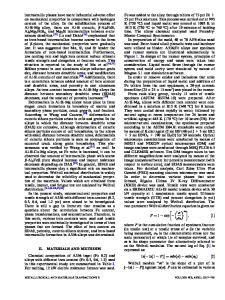The effect of Sr and Fe additions on the microstructure and mechanical properties of a direct squeeze cast Al-7Si-0.3Mg
- PDF / 2,170,184 Bytes
- 16 Pages / 612 x 792 pts (letter) Page_size
- 5 Downloads / 261 Views
I. INTRODUCTION
IN the squeeze-casting process, a tool steel die is filled with molten metal and a pressure is applied to the melt until solidification is complete.[1] The application of pressure results in a high integrity, near-net-shape casting with a good surface finish and dimensional tolerance.[2] The absence of shrinkage porosity due to the long-range interdendritic fluid feeding of solidification shrinkage, combined with a finescale microstructure caused by high cooling rates, results in excellent mechanical properties for both conventional AlSi casting alloys and Al alloys of wrought composition.[1] These advantages for squeeze casting, combined with a production rate comparable to high-pressure die casting, have led to a variety of applications for squeeze-cast components, including pistons, brake calipers, rocker arms, manifolds, rack housings, wheels, suspension arms, and engine mounts for the automotive industry; crank shafts and gear-shift forks for sporting equipment; and disc-drive housings for the electronics industry.[1–4] Despite the industrial interest in squeeze casting, there is little understanding of how the application of pressure affects the microstructure and mechanical properties of squeeze cast material. For example, it has been reported by a number of researchers[1,2,5,6] that a squeeze cast A356 alloy (Al-7Si0.3Mg) has an elongation of up to 10 pct in the T6 condition,
compared to a typical ductility of ,3 pct for gravity die cast material, but the reason for this increase in ductility has not been fully established. Furthermore, with Al-Si casting alloys, the effects of Fe impurity levels and the additions of Sr modifications are not well understood for the squeeze casting process. High Fe contents are not usually acceptable in gravity die cast Al-Si alloys due to a serious reduction in ductility caused by the formation of Fe-Si-aluminides,[7] although low Fe contents result in high raw-material costs and reduced die life. However, it is not clear what level of Fe impurity can be tolerated in a squeeze cast material with a substantially improved ductility as compared to that of a gravity die cast material. Low levels of Sr (,0.02 wt pct) are often added to Al-Si casting alloys for gravity die casting to modify the morphology of the Si particles and, thereby, increase ductility,[8] but it is likely that this procedure will need to be revised for the squeeze casting process, where cooling rates are higher during solidification. In this article, we present results on the microstructure and mechanical properties of an LM25 casting alloy (Al7Si-0.3Mg) manufactured by direct squeeze casting and gravity die casting. The effects of Fe impurity levels and Sr modifications on the microstructure and mechanical properties are described for the alloy in the as-cast and T6 heattreated conditions. II. EXPERIMENTAL
J.X. DONG, formerly SBFS Fellow, Oxford Centre for Advanced Materials and Composites, Department of Materials, University of Oxford, is Research Student, Department of Mining and Metal
Data Loading...











